|
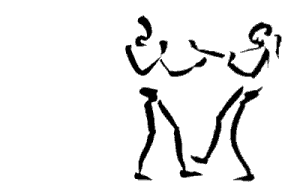
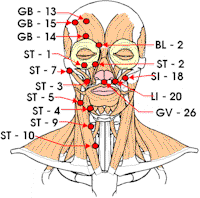
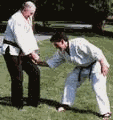

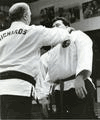

|
Dim Mak, Kyusho-jutsu,
Atemi-Waza, -- (Pressure Point Arts)
"DIM MAK"
(lethal Death Touch fighting art) :
Dim Mak or 'Death Touch' is the art of attacking the vital points on the body. Striking these points in the right direction with the right amount of force will lead to severe reactions such as temporary paralasys, disorientation, knock out or even death. Some of these points relate to acupuncture points, others relate to points on the nervous system and some are located directly above the vital organs.
The secrets of Atemi "body strikes" are used to paralyze
opponents with intense pain, knock out, and kill. Many arts, such as
Aikido, Jiu Jitsu, and acupuncture , teach about special effects caused
by an opponents vitals but none to the extent as this art. This art is
horded by a select and secret few. Masters tend to be cruel and hold
positions of power in organizations or secret societies. This deadly art
has some of the most frightening powers of any martial art. Learning it
does not come without a price.
Aikido and Ji Jitsu can purchase Grab versions
of Atemi strikes
Fighter strikes at one of his opponent's vital points,
causing major debilitization. Foes have been known to crumple in defeat
from one strike.
Pressure Point fighting is a very dangerous and very serious style of fighting. The object is to
interrupt or seize the opponents energy meridians to cause pain, heal, knockout, etc. This form of fighting requires utmost seriousness, safety, and practice. Such common fighting arts as Dim
Mak, Eagle Claw, and even Ryu Kempo use these techniques to overwhelm the opponent. The following is a beginning to understanding this system. There will be additions to the lessons as I recieve the information.
*Pressure points are usually located on a 'meridian' that corresponds to a specific organ. Manipulating these points will cause different reactions upon the corresponding organ. Locating pressure points requires knowledge of meridian, element, and yin/yang classification.
|
|
 |
A Note
by the Author :
"Pressure point KO's (Knock out)
known as "Death Touch" is still a
contervorcial topic and many don't belive it ! Even I haven't
seen it myself.. I have heard and seen on video/TV. But I would
like to challenge a "Death Touch" expert to knock me
down or kill with mere "pressure touch"
alone..(ie a touch alone) !!
Infact I think knocking out people with
just a touch is hard to comprehend ! Most martial arts experts
can knock out or kill chaps with hits/thrusts on vital points..
Even I am confident to put a man down with a hit on vital
points.. It only takes a little power, focus and mental
direction (visualization of internal organs) to do this.
But I don't believe that you can do this
with a mere touch alone ! It takes more than that ! We get hit
many times on most part of our body and don't get KO ! Infact
if pressure touch were so sensitive then a touch could
bring you down !!. I think most of us wouldn't be able to move
or play.. HaaaHaaa. So I don't believe the
"Touch" principle of "Pressure Point
Arts".
Under extreme stress they require a degree of hand eye skill that is all but impossible for the
average person to do.
Every KO in prize fighting history was caused by striking a point on the body that appears on the meridian maps..
that too with a good amount of force/power (NOT a mere touch).
This process can be used to heal people and also for self-defense, where it is called "Dim Mak". The pressure point knowledge, has the objective of hitting spots on the body to damage tendons and nerves.
Dim Mak is the antithesis of acupuncture producing illness or death by disrupting the Chi flow.
So if there is any pressure point expert who think that he could
Knock me down then I except the challenge ! (I can't pay them
hotel rents or plane tickets, but rather its a mental/moral
challenge.. BUT it should be only a "Touch"
NOT a hit or power thrust on my vital points ! So think..
To read more actual truth click
here
All said if you know or are an
expert in this then certainly you can knock out guys with
minimum effort/power... So this is very efficient/deadly art..!!
That's why I have put this science/art on my site. But remember
a hard blow on a vital organ/pressure point could Kill a person !.
So please show utmost disciple when you learn/master this art.
Author: Jimmy George (Email: Webmaster@coolshack.com) |
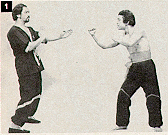
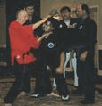
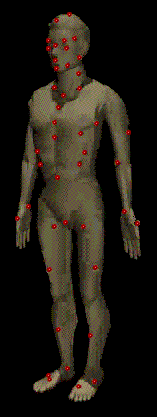

Atemi-Jitsu is a highly refined striking art. When applying Atemi-Jitsu techniques on an opponent, we use the Kyusho points on the limbs, body, and head to act as warning strikes to incoming objects.
KYUSHO JITSU
‘Pressure Points’
KYUSHO - Vital parts of the body :
The Kyusho (weak and lethal points) of the martial arts have to be understood as being separate from other points you may have learned in massage. They are different from the Tsubo (healing points) used in Acupressure and Shiatsu. The effectiveness of the points will differ from person to person and some people will feel absolutely no pain at all so care must be taken. The only way you can learn about the effect of these points is to have the technique done on you so you have personal experience of it.
Study these diagrams and experiment with the points shown. In Ninjutsu, unlike some other arts, we do not restrict ourselves to a small number of vital points - so that we can best control the opponent's body as required.
1) TENDO (crown of head)
2) TENTO (between clown & forehead)
3) KOMEKAMI (temple)
4) MIMI (ears)
5) SEIDON (eyes area)
6) MIKEN (bridge of nose)
7) GANSEI (eyes)
8) JINCHU (under nose)
9) GEKON (under lower hp)
10) MIKAZUKI (jaw)
11) SHOFU (side of neck)
12) DOKKO (behind ears)
13) KEICHU (nape of neck)
14) HICHU (larynx)
15) SONU (between throat & sternum)
16) DANCHU (sternum)
17) KYOTOTSU (sternum base)
18) SUIGETSU (solar plexus)
19) GANCHU (below nipples)
20) KYOEI (between 5th & 6th ribs)
21) DENKO (between 7th & 8th ribs)
22) INAZUMA (body side above hips)
23) MYOJO (below navel)
24) KINTEKI (testicles)
25) SODA (between shoulder blades)
26) KATSUSATSU (middle of spine)
27) JINZO (kidney)
28) KANZO (liver)
29) KODENKO (base of spine)
30) BITEI (Spine end)
31) USHIRO INAZUMA (below buttocks)
32) YUBI (fingers)
33) KOTE (wrist)
34) SHUKO (back of hand)
35) SOTOJAKUZAWA (outer forearm)
36) UCHIJAKUZAWA (inner forearm)
37) HIJIZUME (elbow)
38) UDEKANSETSIJ (arm joint)
39) WANSHUN (back of upper arm)
40) YAKO (inside upper thigh)
41) FUKUTO (outside lower thigh)
42) HIZAKANSETSU (knee)
43) USHIROHIZAKANSETSU (behind knee)
44) KOKOTSU (shinbone)
45) SOBI (base of calf)
46) UCHIKOROBUSHI (inside ankle)
47) KUSAGAKURE (top outer edge of foot)
48) AKIRESUKEN (Achilles tendon)
49) KORI (upper instep)
50) ASHINOYUBI (toes)

Dim Mak according to the Wing Chun Death Touch secret, a person has some 18 prime vital pressure points, and 54 secondary vital pressure points, to make up 72 vital pressure points. The different seasons (Spring, Summer, Autumn and Winter), and the different times of the day, determine the vulnerability of the pressure point. Some of these pressure points are selected from the 34 known meridians, and some are not. There is a special way of striking and applying the force to obtain the optimum result. Usually one would use a Phoenix Knuckle as a weapon for striking. A more advanced practioner might be able to use his finger as a weapon.
"Chi" principle of Dim Mak
:
A well balanced, unimpeded flow of Chi(Ki) is essential for life and well being. It stands to reason therefore that disrupting this energy (chi) flow would result in either unconsciousness or paralysis. This energy can be thought of as an electric current which runs through our body enabling our whole body to work, just like any ectrical appliance will not work without electricity, without the flow of Chi we die.
Advice for Engagement
:
The mind must be calm but alert.
Look for that which is not easily seen.
Use your peripheral vision.
Remain calm when facing your opponent.
Have confident body language and facial expression.
Use a posture that will support mobility.
Laws of Wisdom :
Let anger be your enemy.
Remember, an empty vessel makes the most noise.
Patience is the foundation upon which security and long life rest.
Know well your situation in life.
Trustworthy reputations are only gained from virtuous merit.
Success is the fruit of the strong and wise.
Delay is the best remedy for anger.
Those who will be enlightened are the ones who live moderate lives, have simple tastes, consume natural foods, and pursue the wisdom of sages.
Remain honest in your heart, true to your discipline, and refrain from overindulgence, and you will enjoy great rewards in life.
Mind your manners and your own business.
Discretion is the better part of valor.
The barriers of human achievement lie only in the mind.
An idle mind is a demon’s workshop.
Justice exists for those who live according to the Way, as these are one in the same.
Be happy without cause and make the best of what you have.
True friendship knows no boundaries.
It is a humble virtue to be wealthy and not affected by it.
Cause and effect are mutually consistent.
Despair is the conclusion of fools. Tomorrow’s success is built upon yesterday’s failures. Live in the here and now. Do not seek more but learn to enjoy less.
References:
Funakoshi Gichin. (1935) Karatedo Kyohan. Tokyo, Kobundo.
Gekkan Karatedo ed. (1999) "Kyusho no Himitsu (The Secrets of Vital Points)." Gekkan Karatedo (Karatedo Monthly Magazine) Special Edition.
McCarthy, P. (1995) Bubishi: The Bible of Karate. Tokyo: C.E. Tuttle.
Muromoto, W. (1998). "The Legacy of Chin Genpin." Furyu: The Budo Journal, #8.
Jin Yiming (1928). Secrets of Wudang Boxing. Translation of section on Vital Points, tr. Patrick McCarthy, 1994).
Sato K. (1996). Seiden Jissen Tenketsu-jutsu. (Orthodox Dim Xue for Real Fighting) Tokyo: Baseball Magazine.
Tokashiki I. (1995) Okinawa Karate Hiden Bubishi Shinshaku. (Okinawa Karate Secrets: A New Interpretation of the Bubishi). Naha, Privately Published.
Zarrilli, P. (1992) "To heal and/or harm: The vital spots (marmmam/varmam) in two south Indian martial traditions." Journal of Asian Martial Arts. Vol. 1:1 and 1:2.
To better illustrate, the points will be listed by meridian. The fourteen meridians are:
Bladder
Conception
Gall Bladder
Governor
Heart
Kidney
Large Intestine
Liver
Lung
Pericardium
Small intestine
Spleen
Stomach
Triple Warmer
Questions
regarding pressure point art :
Q: Why haven't I heard about the use of Pressure Points as applied to my traditional kata?
A: According to Master Hohan Sokon, one of the great Okinawan masters of our time, this aspect of the Okinawan Martial Arts was considered "Old Man's Karate." It was not taught until after the age of 45 years old and above the rank of Go-dan (5th Degree Black Belt). It was reserved until later in life when the student had trained with their instructor for many years and was thus well trusted. Master Hohan Sokon further stated that many of the top foreign Black Belts, including Americans, were not taught these aspects of the arts due to their age and the lack of knowing them for the required time.
Q: Does this relate to my style of Martial Arts?
A: Definitely. Understanding know to properly use Pressure Points and energy transfer in your kata (or forms) and self-defense techniques makes you much more efficient. This art was referred to as "Old Man's Karate" because it did not require great strength to accomplish the techniques. As one progresses in age, it is natural to lose some strength. This art is also a wonderful system for young people if they have reached enough maturity to understand it. The youngsters should be taught a simplified version of the system that lacks the most serious and deadly of the techniques.
Once you begin to see and learn these techniques, you will realize that our katas are full of them. Every technique in your kata should have anywhere from five to ten applications (Bunkai) using nerve centers and/or pressure points. It is this aspect of our art that is guaranteed to make the study of kata much more enjoyable and rewarding for years to come.
Q: What is Chi (Ki or Energy)?
A: Chi, also known as Ki or Energy, is the combination of thought, breath, and blood that results in the energy used by the body to sustain activity. It is an invisible force that can only be felt and not seen. It is the basis for many internal arts such as Hsing-I and Tai Chi Chuan to name a few. It is further used in the external arts such as karate. For our studies, Chi must be examined from two perspectives:
1. We must understand how to transfer this energy into our strikes to cause more damage in our strikes.
2. We must understand how it flows in the human body so that we can manipulate its flow and again cause further
damage in our opponent.
Q: What is a Meridian?
A: A meridian is a channel through which Chi flows. It may be compared to a blood vessel which routes blood through the body. The meridian is responsible for routing the Chi from their source through their pared home organ or bowel into the next meridian. There are twelve Main Meridians and eight Extra Meridians. The twelve Main Meridians are listed below. At this time, we will restrict our studies of the Extra Meridians to the Conception Vessel and the Governing Vessel. The Chi that flows through each of the meridians provides the energy for its pared organ or bowel that allows it to function. If this energy were to not flow properly, disease or death would be the result. This circuit is referred to as the Diurnal Cycle. The proper sequence of the Diurnal Cycle is illustrated below:
Lung to Large Intestine to Stomach to Spleen to Heart to Small Intestine to Bladder to Kidney to Pericardium to Triple Warmer to Gall Bladder to Liver and back to Lung.
Once the energy exits the Liver meridian it will return to the Lung meridian and the process starts all over. This flow of energy will take 24 hours to complete. Please note that there is always energy flowing through each of the meridians, and not only at the times listed. The times listed are when the energy peaks in each of the respective meridians. The energy will be highest in each of the meridians for approximately two hours at various times of the day as listed below:
Lung: 3AM to 5AM
Large Intestine: 5AM to 7AM
Stomach: 7AM to 9AM
Spleen: 9AM to 11AM
Heart: 11AM to 1PM
Small Intestine: 1PM to 3PM
Bladder: 3PM to 5PM
Kidney: 5PM to 7PM
Pericardium: 7PM to 9PM
Triple Warmer: 9PM to 11PM
Gall Bladder: 11PM to 1AM
Liver: 1AM to 3AM
Q: What is Yin/Yang?
A: Energy is either Positive (Yang) or Negative (Yin). According to the Chinese, Yin/Yang translates as 10,000 things. For our studies at the present time, we will use this concept to label each of the twelve meridians as either Yin or Yang. The Yin meridians flow on the front of the body and on the insides of the arms and legs. The Yang meridians flow on the back of the body and on the outside of the arms and legs.
YIN ORGANS........................YANG BOWELS
Lung.........................................Large Intestine
Spleen......................................Stomach
Heart........................................Small Intestine
Kidney......................................Bladder
Pericardium...............................Triple Warmer
Liiver.........................................Gall Bladder
Q: What are the Five Elements?
A: Each of the twelve meridians are associated with one of five elements: wood, fire, earth, metal, and water. For our purposes in the martial arts, we need to know how these associations interact with each other. (This will be further discussed in the question below.) The elements are associated in such a way that each element is paired with two of the twelve meridians, with the exception of Fire, which is paired with four meridians.
WOOD: Gall Bladder and Liver
FIRE: Heart, Small Intestine, Pericardium, and Triple Warmer
EARTH: Stomach and Spleen
METAL: Lung and Large Intestine
WATER: Bladder and Kidney
Q: What laws govern the flow of energy?
A: The Destructive Cycle and the Constructive Cycle. The Constructive Cycle is the system also known as the Nourishing Cycle. As the name implies, this system is responsible for providing the nourishing energy for each of the meridians, organs, and bowels. The energy will flow in the following circuit.
CONSTRUCTIVE CYCLE
WOOD creates FIRE
FIRE creates EARTH
EARTH creates METAL
METAL creates WATER
WATER creates WOOD
There is also a Destructive Cycle which is meant to be a system of checks and balances. The Destructive Cycle is the controlling cycle. This is the system that we will use the most to cause havoc on the human body. Most of the techniques you will learn will use this system. It is outlined below:
DESTRUCTIVE CYCLE
WOOD penetrates EARTH
EARTH contains WATER
WATER extinguishes FIRE
FIRE burns METAL
METAL cuts WOOD
Q: Is it possible to cause a Knock Out using Pressure Point Techniques?
A: Yes. Once you have learned the system of pressure point fighting, you will be able to knock out virtually any opponent with a minimum of force applied.
Q: Is it possible to apply these techniques in a real fight?
A: Yes. These same techniques are taught in my school to Police Officers and S.W.A.T. Team personnel. They have tested and proven the techniques to work in a variety of real life situations with uncooperative opponents to say the least. These techniques work for everyone regardless of size or age. Wasn't that the original purpose of martial arts?
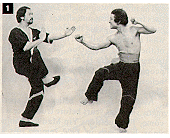
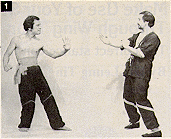
Chest and Abdomen Kyusho Points
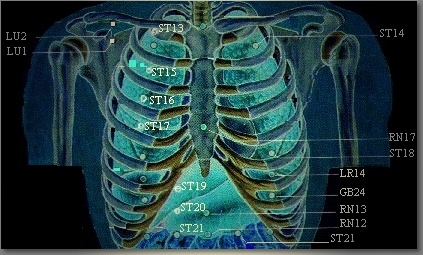
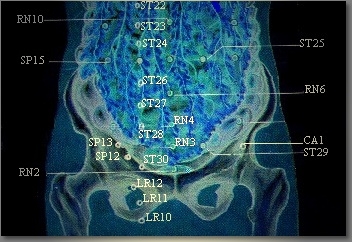
  
|















